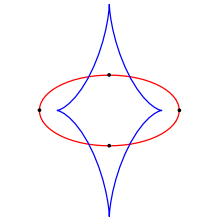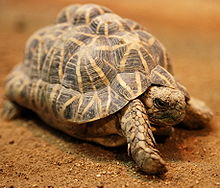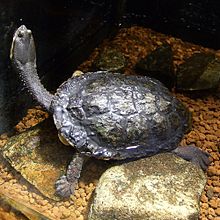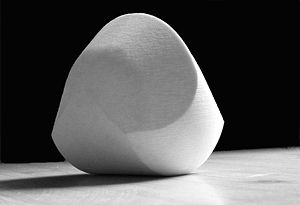- Gömböc
-
"Gomboc" redirects here. For the Slovene astrophysicist, see Andreja Gomboc.
A gömböc (pronounced [ˈɡømbøts] in Hungarian, sometimes spelled gomboc and pronounced GOM-bock in English) is a convex three-dimensional homogeneous body which, when resting on a flat surface, has just one stable and one unstable point of equilibrium. Its existence was conjectured by Russian mathematician Vladimir Arnold in 1995 and proven in 2006 by Hungarian scientists Gábor Domokos and Péter Várkonyi. The gömböc shape is not unique; it has countless varieties, most of which are very close to a sphere and all have very strict shape tolerance (about 0.1 mm per 10 cm). The most famous solution has a sharpened top and is shown on the right. Its shape helped to explain the body structure of some turtles in relation to their ability to return to equilibrium position after being placed upside down.[1][2][3][4] Copies of gömböcs have been donated to institutions and museums, and the biggest one was presented at the World Expo 2010 in Shanghai, China.[5][6]
Contents
History
In geometry, a body with a single stable resting position is called monostatic, and the term mono-monostatic has been coined to describe a body which additionally has only one unstable point of balance. (The previously known monostatic polyhedron does not qualify, as it has three unstable equilibria.) A sphere weighted so that its center of mass is shifted from the geometrical center is a mono-monostatic body. A more common example is the Comeback Kid, Weeble or roly-poly toy (see left figure). Not only does it have a low center of mass, but it also has a specific shape. At equilibrium, the center of mass and the contact point are on the line perpendicular to the ground. When the toy is pushed, its center of mass rises and also shifts away from that line. This produces a righting moment which returns the toy to the equilibrium position.
The above examples of mono-monostatic objects are necessarily inhomogeneous, that is, the density of their material varies across their body. The question of whether it is possible to construct a three-dimensional body which is mono-monostatic but also homogeneous and convex was raised by Russian mathematician Vladimir Arnold in 1995. The requirement of being convex is essential as it is trivial to construct a mono-monostatic non-convex body. Convex means that any straight line between two points on a body lies inside the body, or, in other words, that the surface has no sunken regions but instead bulges outward (or is at least flat) at every point. It was already well known, from a geometrical and topological generalization of the classical four-vertex theorem, that a plane curve has at least four extrema of curvature, specifically, at least two local maxima and at least two local minima (see right figure), meaning that a (convex) mono-monostatic object does not exist in two dimensions. Whereas a common anticipation was that a three-dimensional body should also have at least four extrema, Arnold conjectured that this number could be smaller.[7]
Mathematical solution
 An ellipse (red) and its evolute (blue), showing the four vertices of the curve. Each vertex corresponds to a cusp on the evolute.
An ellipse (red) and its evolute (blue), showing the four vertices of the curve. Each vertex corresponds to a cusp on the evolute.
The problem was solved in 2006 by Gábor Domokos and Péter Várkonyi. Domokos is an engineer and is the head of Mechanics, Materials and Structures at Budapest University of Technology and Economics. Since 2004, he is the youngest member of the Hungarian Academy of Sciences. Várkonyi was trained as an architect; he was a student of Domokos and a silver medalist at the International Physics Olympiad in 1997. After staying as a post-doctoral student at Princeton University in 2006–2007, he assumed an assistant professor position at Budapest University of Technology and Economics.[7][8] Domokos had previously been working on mono-monostatic bodies. In 1995 he met Arnold at a major mathematics conference in Hamburg, where Arnold presented a plenary talk illustrating that most geometrical problems have four solutions or extremal points. In a personal discussion, however, Arnold questioned that four is a requirement for mono-monostatic bodies and encouraged Domokos to seek examples with fewer equilibria.[9]
The rigorous proof of the solution can be found in references of their work.[7] The summary of the results is that the three-dimensional homogeneous convex (mono-monostatic) body, which has one stable and one unstable equilibrium point, does exist and is not unique. Such bodies are hard to visualize, describe or identify. Their form is dissimilar to any typical representative of any other equilibrium geometrical class. They should have minimal "flatness", and, to avoid having two unstable equilibria, must also have minimal "thinness". They are the only non-degenerate objects having simultaneously minimal flatness and thinness. The shape of those bodies is very sensitive to small variation, outside which it is no longer mono-monostatic. For example, the first solution of Domokos and Várkonyi closely resembled a sphere, with a shape deviation of only 10−5. It was dismissed, as it was extremely hard to test experimentally.[10] Their published solution was less sensitive; yet it has a shape tolerance of 10−4, that is 0.1 mm for a 10 cm size.[11]
Domokos and his wife developed a classification system for shapes based on their points of equilibrium by analyzing pebbles and noting their equilibrium points. In one experiment, they tried 2000 pebbles collected at the beaches of Rhodes island and found no single mono-monostatic body among them, illustrating the difficulty to find or construct such a body.[7][10]
The solution of Domokos and Várkonyi has curved edges and resembles a sphere with a squashed top. In the top figure, it rests in its stable equilibrium. Its unstable equilibrium position is obtained by rotating the figure 180° about a horizontal axis. Theoretically, it will rest there, but the smallest perturbation will bring it back to the stable point. The mathematical gömböc has indeed sphere-like properties. In particular its flatness and thinness are minimal, and this is the only type of nondegenerate object with this property.[7] Domokos and Várkonyi are interested to find a polyhedral solution with the surface consisting of a minimal number of flat planes. Therefore, they offer a prize to anyone who finds such solution, which amounts to $10,000 divided by the number of planes in the solution. Obviously, one can approximate their curvilinear gömböc with a finite number of discrete surfaces, however, their estimate is it will take thousands of planes to achieve that. They hope, by offering this prize, to stimulate finding a radically different solution from their own.[4]
Name
If analyzed quantitatively in terms of flatness and thickness, the discovered mono-monostatic body is the most sphere-like body, apart from the sphere itself. Because of this, it was named gömböc, meaning a diminutive of gömb ("sphere" in Hungarian). Originally gömböc is a sausage-like food: seasoned pork filled in pig-stomach. There is a Hungarian folk tale about an anthropomorphic gömböc, which swallows several people whole.[12]
Relation to animals
 The shape of the Indian Star Tortoise resembles a gömböc. This turtle rolls easily without relying much on its limbs.
The shape of the Indian Star Tortoise resembles a gömböc. This turtle rolls easily without relying much on its limbs.
The balancing properties of the gömböc are associated with the "righting response", their ability to turn back when placed upside down, of shelled animals such as turtles and beetles. This may happen in a fight or predator attack and is crucial for their survival. The presence of only one stable and unstable point in a gömböc means that it would return to one equilibrium position no matter how it is pushed or turned around. Whereas relatively flat animals (such as beetles) heavily rely on momentum and thrust developed by moving their limbs and wings, the limbs of many dome-shaped turtles are too short to be of use in righting themselves.
Domokos and Várkonyi spent a year measuring turtles in the Budapest Zoo, Hungarian Museum of Natural History and various pet shops in Budapest, digitizing and analyzing their shells, and attempting to "explain" their body shapes and functions from their geometry work. Their first biology paper was rejected 5 times, but finally accepted by the biology journal Proceedings of the Royal Society. It was then immediately popularized in several science news reports, including those of the most prestigious science journals Nature[3] and Science.[4][13] The reported model can be summarized as flat shells in turtles are advantageous for swimming and digging. However, the sharp shell edges hinder the rolling. Those turtles usually have long legs and neck and actively use them to push the ground, in order to return to the normal position if placed upside down. On the contrary, more "round" turtles easily roll on their own; those have shorter limbs and use them little when recovering lost balance. (Some limb movement would always be needed because of imperfect shell shape, ground conditions, etc.) Round shells also resist better the crushing jaws of a predator and are better for thermal regulation.[1][2][3][4]
 Argentine Snake-necked Turtle is an example of a flat turtle, which relies on its long neck and legs to turn over when placed upside down.
Argentine Snake-necked Turtle is an example of a flat turtle, which relies on its long neck and legs to turn over when placed upside down.
The explanation of turtle body shape, using the gömböc theory, has already been accepted by some biologists. For example, Robert McNeill Alexander, one of the pioneers of modern biomechanics, used it in his plenary lecture on optimization in evolution in 2008.[14]
No other practical applications of gömböcs are known, probably because a gömböc is an exotic solution for an idealized case of homogeneous solid – although balance recovery is crucial in such areas as robotics, it is typically achieved simply by making the bottom parts heavier.[3]
Production
The strict shape tolerance of gömböcs hindered production. The first prototype of a gömböc was manufactured in summer 2006 using three-dimensional Rapid Prototyping technology. Its accuracy however was below requirements, and the gömböc would often get stuck in an intermediate position rather than returning to the stable equilibrium. The technology was improved to increase the spatial accuracy to the required 10−4 level and to use various construction materials. In particular, transparent (especially lightly colored) solids are visually appealing, as they demonstrate the homogeneous composition. Current materials for gömböcs include aluminium alloy (AlMgSi), brass, Plexiglass and marble. The balancing properties of a gömböc are affected by mechanical defects and dust both on its body and on the surface on which it rests. If damaged, the process of restoring the original shape is more complex than producing a new one.[15] Although in theory the balancing properties should not depend on the material and object size, in practice, both larger and heavier gömböcs have better chances to return to equilibrium in case of defects.[16]
Gömböc 1 was a gift to Vladimir Arnold on occasion of his 70th birthday.[17] The largest gömböc is about 3 meters high and 3 meters wide. It was the major exhibit of the Hungarian pavilion at the World Expo 2010 in Shanghai, China.[5][6]
Media
The invention of the gömböc has been in the focus of public and media attention, repeating the success of another Hungarian Ernő Rubik when he designed his cube-shaped puzzle in 1974.[18] For their discovery, Domokos and Várkonyi were decorated with the Knight's Cross of the Republic of Hungary.[19] The New York Times Magazine selected the gömböc as one of the 70 most interesting ideas of the year 2007.[20][21]
On February 13, 2009, a gömböc appeared on on BBC One Friday night show QI, where the host Stephen Fry demonstrated its properties and Domokos, who was present in the audience, explained its history and relation to turtles.[22]
The June 28, 2010 issue of Linn's Stamp News shows the new stamps issued on April 30, 2010 by Hungary which illustrate a gömböc in different positions. The stamp booklets are arranged in such a manner that the gömböc appears to come to life when the booklet is flipped. The stamps were issued in association with the gömböc on display at the World Expo 2010 (May 1 to October 31).[23]
See also
References
- ^ a b Domokos, G.; Varkonyi, P.L. (2008). "Geometry and self-righting of turtles" (free download pdf). Proc. R. Soc. B 275 (1630): 11–17. doi:10.1098/rspb.2007.1188. PMC 2562404. PMID 17939984. http://www.pubmedcentral.nih.gov/articlerender.fcgi?tool=pmcentrez&artid=2562404.
- ^ a b "The Living Gömböc. Some turtle shells evolved the ideal shape for staying upright". Natural History. March 2009. http://www.naturalhistorymag.com/biomechanics/10309/the-living-gomboc.
- ^ a b c d Ball, Philip (16 October 2007). "How tortoises turn right-side up". Nature News. doi:10.1038/news.2007.170. http://www.nature.com/news/2007/071016/full/news.2007.170.html.
- ^ a b c d Julie Rehmeyer. "Can't Knock It Down". Science News. http://www.sciencenews.org/view/generic/id/8383/title/Cant_Knock_It_Down.
- ^ a b Hungary Pavilion features Gomboc, 12 July 2010
- ^ a b New geometric shape "Gomboc" featured at Shanghai Expo, English.news.cn, 19 August 2010
- ^ a b c d e Varkonyi, P.L., Domokos, G. (2006). "Mono-monostatic bodies: the answer to Arnold's question". The Mathematical Intelligencer 28 (4): 34–38. http://www.gomboc.eu/100.pdf.
- ^ Inventors. Retrieved on 2011-06-22.
- ^ My Lunch with Arnol’d by Gabor Domokos
- ^ a b Marianne Freiberger (May 2009). "The story of the gömböc". http://plus.maths.org/issue52/features/gomboc/index.html?nl=0.
- ^ "The first gömböc". gomboc.eu. http://www.gomboc.eu/site.php?inc=0&menuId=20.
- ^ A kis gömböc, a folk tale in Hungarian
- ^ "Gömböc – Finding Consilience". February 14, 2008. http://www.quickswood.com/my_weblog/2008/02/gmbc-finding-co.html.
- ^ Professor Alexander on the Turtles and the Gömböc. Gomboc.eu. Retrieved on 2011-06-22.
- ^ Usage of a gömböc. Retrieved on 2011-06-22.
- ^ Does the behavior of a gömböc depend on the size or the material?. Retrieved on 2011-06-22.
- ^ Knight's Cross for the Gömböc, Gömböc for Arnold. Gomboc.eu. Retrieved on 2011-06-22.
- ^ "Boffins develop a 'new shape' called Gomboc". Melbourne: Theage.com.au. February 13, 2007. http://www.theage.com.au/news/technology/is-gomboc-the-shape-of-things-to-come/2007/02/13/1171128948286.html.
- ^ A Gömböc for the Whipple.
- ^ The gömböc in the New York Times Magazine. Gomboc.eu. Retrieved on 2011-06-22.
- ^ Whose Bright Idea Was That? The New York Times Magazine Ideas of 2007. Inventorspot.com (2007-12-09). Retrieved on 2011-06-22.
- ^ Gömböc ("QI": Series F Episode 8). Youtube.com (2009-07-12). Retrieved on 2011-06-22.
- ^ "World of New Issues: Expo stamps picture Hungary's Gomboc, Iceland's ice cube" by Denise McCarty Linn's Stamp News page 14 (June 28, 2010)
External links
Categories:- 2006 in science
- 2006 introductions
- 2006 in Hungary
- Euclidean solid geometry
- Science and technology in Hungary
- Statics
- Hungarian inventions
Wikimedia Foundation. 2010.


